![]()
Striving to modernize the NYPD and improve police services to the City of New York, progressive thinking Police Commission Richard E. Enright, issued a formal order to established two ‘Emergency Automobile Squads’ on July 25, 1925.
Six sergeants that were to be assigned to the two squads were then transferred to the police academy for five days to prepare and familiarize themselves with rescue techniques and the equipment.
The actual date that the squads went into service was July 12, 1925. Each squad to have one lieutenant, three sergeants and 21 patrolmen, all assigned to work around the clock. However, going through the personnel orders, no lieutenants were ever transferred to Emergency Service until 1930.
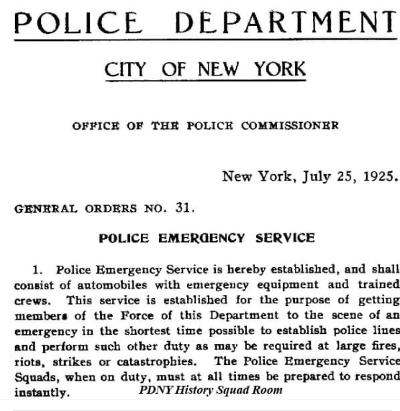
It has to be noted here, that although both squads were designated “Emergency Automobile Squads” and given the numbers: 1 and 2, the lettering on both sides of their trucks read, “Emergency Service”.
The original intention was to have the newly minted ‘Emergency Automobile Squads’ perform as a combination rescue squad and riot platoon. Furthermore, all the men were trained and proficient in the art of administering the latest in first aid and medical care.
In the beginning, each squad was designated to respond to all fires of two alarms or more, riots, train wrecks and serious automobile collisions, and other emergencies where there were serious injuries or people were likely to die.
Emergency Squad #1 was quartered at 138 West 30th Street in Manhattan and was assigned to respond to emergencies in Manhattan and the Bronx. The men reported to and were under the supervision of the Commanding Officer of the 7th Precinct.
Emergency Squad #2 was quartered in Brooklyn at 298 Classon Ave. and reported to the Commanding Officer of Brooklyn’s 46th Precinct. Squad #2 was assigned to respond to emergencies in Brooklyn and Queens.
personnel
The Very First E-Men That Made It All Work
(NYPD Special Order # 171 dated 7- 6-1925)
Assigned to Duty on Emergency Automobile # 1
- Sgt. James M. Gordon Jr.
- Sgt. Joseph A. Stanton
- Sgt. John F. Ward
Patrolmen:
- William J. Bak
- Otto W. Behrens
- John J. Boyle
- Frank A. Dineen
- Daniel J. Flynn
- Henry Fleuchaus
- John J. Hartnett
- James A. Irving Jr.
- Frederick Kahrig
- William Kaval
- Daniel F. Kerrigan
- Francis M. Kelly
- Albert E. Latchford
- George C. Moench
- John D. Paar
- Frederick L. Pfeiffer
- Edward F. Powers
- Frederick H. Sorger
- Laurence H. Spitzen
- Joseph Theuer
- John Tormey
Assigned to Duty on Emergency Automobile # 2
- Sgt. Ulysses E. Beotig
- Sgt. David Geraghty
- Sgt. Joseph Green
Patrolmen:
- Ernest M. Emann
- Charles Frailer
- John J. Hartnett
- James F. O’Brien
- Francis J. Donnelly
- Charles Dosch
- Joseph V. DeSoucey
- William Ferri
- Michael P. Higgins
- Edward O. Junginger
- Charles P. Klein
- Charles E. Kraemer
- Walter G. Lagarenne
- Edward B. Lahey
- Edwin L. Lundin
- Joseph F. Motjenbacker
- Ernest Peters
- Edward F. Powers
- Thomas C. Regan
- John M. Simerlein
- Arthur F. Walz
- Albert L. Williamson
- Edward Unger
All the men that were chosen were chosen for their proficient in:
- Handling crowbars.
- Using jimmies.
- The use of blocks and tackles.
- Their expertise in heavy jacks used for lifting cars and other vehicles.
- They received training in the following:
- Forming policing lines at fires
- Extricating people from under trains.
- Rescuing horses from rivers
- Digging victims out from under debris.
They were also trained in the use of inhalators, machine guns, tear gas bombs and all the other paraphernalia with which the truck was equipped.
Equipment
Both squads got brand spanking new 1925 White Motor Trucks that were painted enameled dark blue with “Emergency Service” prominently painted in gold leaf on both sides of each truck.
The equipment carried on both trucks:
- 12 Fire Axes
- 2 Pulmotors
- 6 Acetylene torches
- 1 Life line
- 1 Rope cannon
- 8 Stretchers
- 6 Hydraulic jacks
- 6 Searchlights
- 4 Cot beds
- 6 Camp chairs
- 1 Full Medical chest of complete surgical equipment
- 6 Gas helmets
- 6 Blankets
- Special work clothing
- Various other tools for rescue work.
Emergency Service’s First Mascot
Squad # 1 adopted a Kerry blue terrier that they named “Bum”. They found the dog, which had been shot in the head and unconscious, on one of their first jobs. Luckily the wound turned out to be only a graze and they nursed “Bum’ back to health. “Bum” basically lived and slept on the truck. He would loyally ride with the squad to all jobs, sitting on the front seat between the sergeant and the chauffer. The N.Y. Times reported that Bum repaid them by faithfully guarding the truck.
ESU’s first Major Job
On August 17, 1925, NYPD Emergency Automobile Squad #1 responded to old 8th Regiment Armory, located at 410 West 27th Street for the collapse of a 20,000 gallon, 60 foot high steel water tanks in which two boys were seriously injured, and approximately 400 women and young children in an adjoining park had been knocked around and were almost drowned by the cascading water. They operated at this location from 1030 hours to 1530 hours, performing various rescue functions and administering first aid to the many injured.
The NYPD Emergency Squad Stars at the 1925 Annual Police Games
We know from the 1925 NYPD Annual Police games (September, 1925) held at the old Jamaica Race Track that the “Emergency Squad” put on a show for Police Commissioner Richard Enright and NYC Mayor John F. Hyland.

Just a little explanation of the police games before we continue. In the good old days before T.V. and DVDs, each and every year, similar to today’s Olympics, all the precincts would compete against each other in various athletic events, i.e. boxing, wrestling, track, and throwing weights for trophies and prizes.
While all this was going on, three bands played, as various commands put on displays of police work for the 30,000 or so spectators who showed up. Examples: Mounted Traffic cops performed close order cavalry dills and the rookies from the academy marched here and there in precision formations. Many commands also performed various skits depicting the various facets of police work.
Among the various featured events, six mounted patrolmen competed in a horse race that was probably the highlight of the day for most of the cops. The department’s supposedly six fastest steeds ran for a department’s trophy. But I’m willing to bet that most of the cops at the games in all probability wagered some big money on the outcome.
For the public, however, the reported highlight of that year was the Emergency Squad’s “emergency wagon” and show. E-men, using the latest police weapons and riot guns staged a skit. The squad, using police officers as actors, and two police dogs, showed just how they would capture a barricaded violent felon, complete with simulated tear gas and blank rounds.
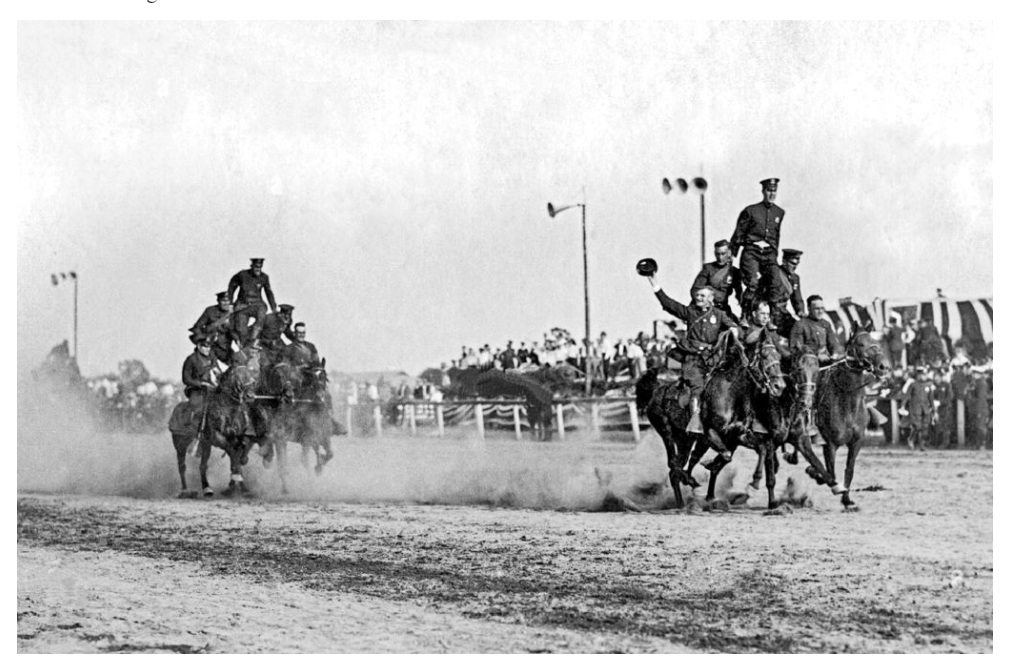
September 14, 1925.
Brooklyn’s Emergency Squad #2 Snake Job
From the NY Times’ (Oct. 8, 1925 front page), Bklyn. Emergency Squad 2 with six patrolmen under the command of Sgt. Ulysses Beotig responded to 176 71 Street in Bay Ridge, Brooklyn to deal with a large snake. They used tear gas bombs and ammonia to deal with the serpent. (Sounds like a little overkill, but then too they were just slightly new at this stuff.)
FDNY RECOGNIZES EMERGENCY SERVICE
New York Fire Department General Order No.7 of January 21, 1926, announces that “Police Emergency Wagons” have been placed in service. One in Manhattan and the other in Brooklyn. Either or both may be called to the scene of a fire anywhere in the city in the same manner as any fire apparatus.
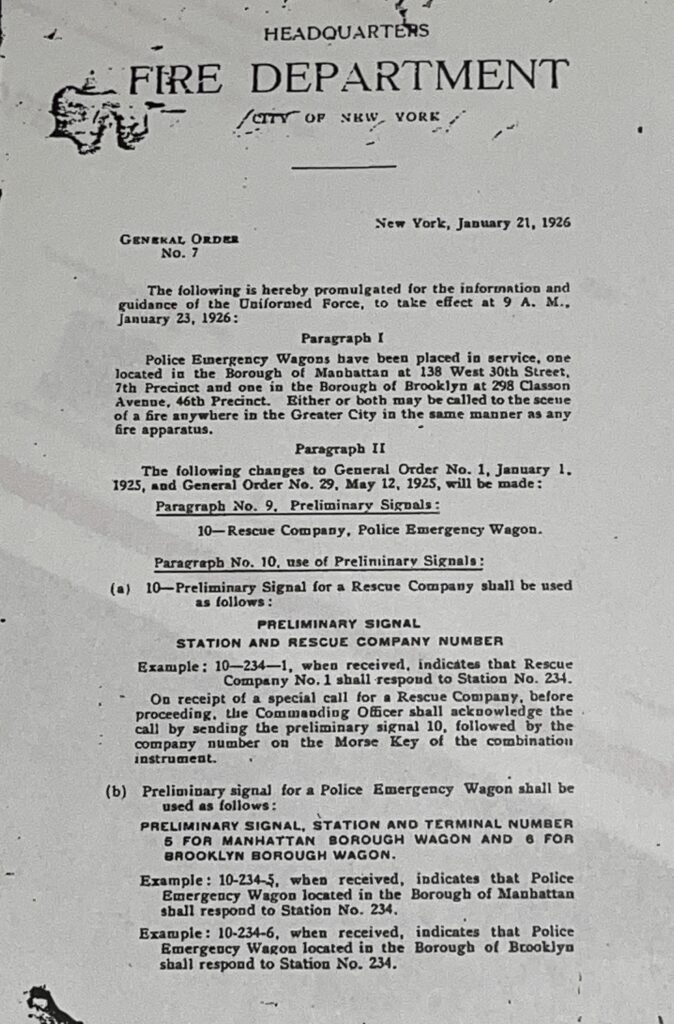
Emergency Automobile Squad #1 Responds at the Request of FDNY and Saves 4 Firemen
On June 13, 1926 the FDNY requested the assistance of the police emergency squad with gas masks at a fire in the basement of 46 East Broadway in Manhattan.
E-men wearing gas masks rescued an FDNY captain and three firemen from Engine Co. 9, all of whom had passed out from smoke in the basemen of that building. (June 14, 1926 N.Y. Times pg. 21)
The ‘Emergency Automobile Squads’ are Renamed The ‘Emergency Service Squads’ – September 16, 1926 Emergency Squad #3 is Organized in the Bronx
The first two automobile emergency squads proved to be so successful, that Police Commission George McLaughlin ordered that a third Emergency Service Squad be organized and based in the Bronx. On September 16, 1926, it went into service at 820 Washington Ave. and reported to the Commanding Officer of Bronx’s 19th Pct. They too receive a brand new ‘White Motor Truck’
Assigned to Duty – Emergency Service Squad # 3
The special order read, “From precincts indicated to 19th, assigned to duty on Emergency Service Squad”
- Sgt. John Cox
- Sgt. Emil Jahika
- Sgt. John P. Roche
Patrolmen:
- Edward M. Barry
- Patrick J. Brennan
- James F. Byrne
- Joseph A. Clements
- Patrick J. Hynes
- William J. Hughes
- Joseph Janda Jr.
- George Malberger
- Granville Mills
- William F. Murray
- Arthur J. Nelson
- James B. Nolan
- Frank J. Pipolo
- Harold F. J. Plate
- James A. Sheppard
- Russell A. Shopland
- James A. Walsh
- Adolph Westedt
- James J. Watson
It its first year Emergency Service Squad #3 successfully handled 558 emergency jobs.
Emergency Service Handles Its 1st Major Gun Battle
On November 3, 1926 E-men had their first major gun battle. At 3:15 in the afternoon, three prisoners attempted to escape from the old ‘Tombs’ on Centre Street (Jail attached to Manhattan Criminal Court). Two correction officers and two perps were killed in the ensuing gun battle. Three other perps were also shot. According to the N.Y. Times (front page Nov. 4, 1926), E-men from nearby buildings raked the jail from all sides with “heavy machine gun fire and gas bombs”.
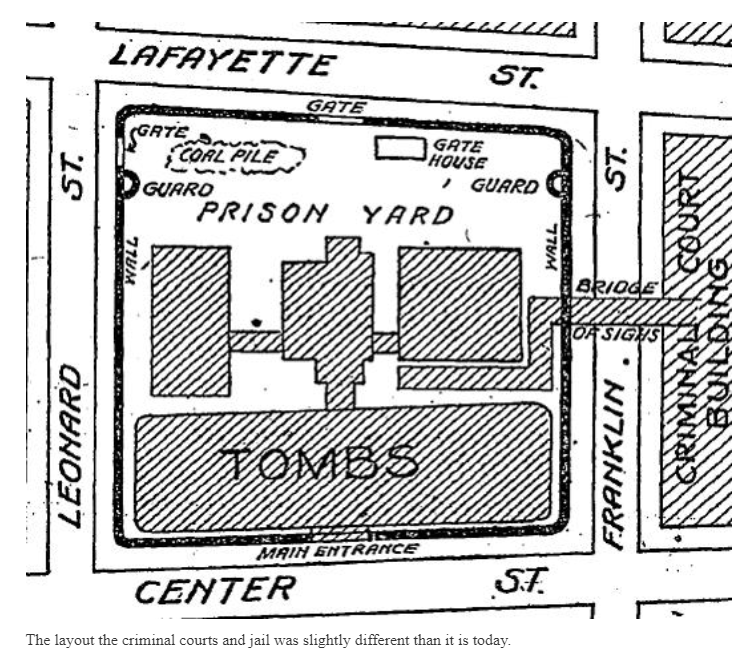
The layout the criminal courts and jail was slightly different than it is today.
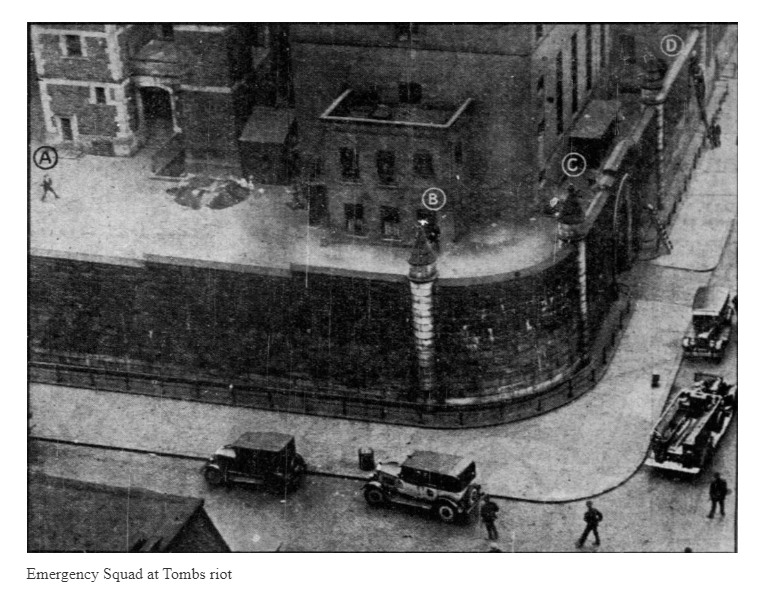
Emergency Squad at Tombs riot
First Emergency Service Patrolmen to Receive a Medal
On December 21, 1927, Patrolman Walter Grebner of Brooklyn’s Emergency Service Squad #2 was awarded a ‘Commendation’ to become the first member of Emergency Service ever to be awarded a medal.
“At about 2 p.m., May 24, 1927, while on emergency service duty, dived several times from a boat in an effort to save a man from drowning in New York Bay, off 52nd Street, Brooklyn.”
may 4, 1928 – police Emergency Service is hereby established
Police Department General Order #11 of May 4, 1928, See next paragraph for more.

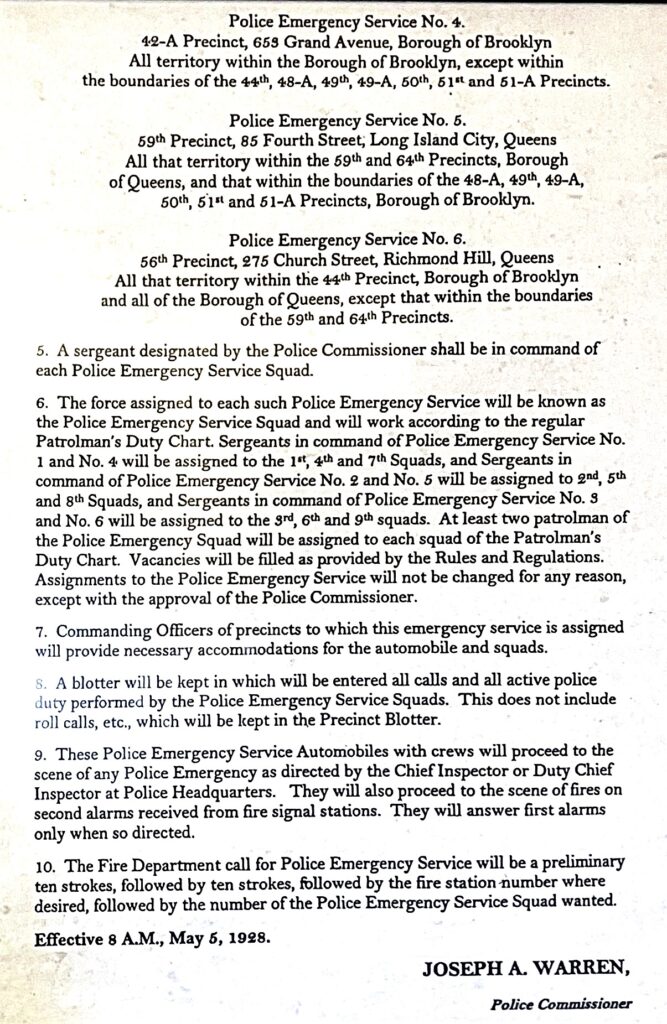
May 5, 1928 – The NYPD Expands to Six Emergency Service Squads
All E.S.S. are now connected to FDNY’s Fire Alarm Telegraph System
The department now expands to six Emergency Service Squads, each consisting of three sergeants and twenty one patrolmen. All are equipped with fire-fighting apparatus, gas masks, blocks and tackles, acetylene torches, automatic weapons, tear gas bombs, search lights, heavy rubber gloves, pulmotors, oxygen tanks and first aide kits and more. Emergency Service Squad #2 is renumbered. All NYPD Emergency Service Squads moreover are now hooked into FDNY fire alarm telegraph system and now receive all alarms of fire in their quarters.
- Squad #1 based out of West 30th Street now covers all of Manhattan south of 86th Street, including all of Central Park and the Borough of Richmond.
- Squad #2 A new ESU is established at the 15th Precinct, 1854 Amsterdam Ave. and covers all of Manhattan north of 86th Street with the exception of Central Park.
- Squad #3 continues to work out of the 19th Pct., 820 Washington Ave. and covers the Bronx.
- Squad #4 Brooklyn’s old Squad #2 is renumbered to Squad #4 and moves from Brooklyn’s 46 Pct. to Brooklyn’s 42-A Precinct, located at 653 Grand Ave. (The old 80 Precinct) and now provides emergency rescue service to Central and South Brooklyn.
- Squad #5 is established in 59th Precinct Station House, 5-47 50th Ave. and covers Long Island City, Astoria and most of Brooklyn North.
- Squad #6 is located at the 56th Precinct Station House, 87-34 118th Street in Richmond Hill and covers all of Queens with the exception of Long Island City and Astoria.
September 1, 1928 – 12 NYPD E-men Are Assigned to work in FDNY Rescue Companies for 30 days to Familiarize Themselves with FDNY Operations
The FDNY requests that the NYPD familiarizes all E-men with FDNY rescue procedures. Consequently, twelve NYPD E-men were sent over to the FDNY to work in their Rescue Companies for 30 days. To paraphrase FDNY Assistant Chief of Department Joseph Martin, ‘They are requested with the purpose of familiarizing themselves with the use of the tools and appliances of the FDNY rescue squads, and to create a greater cooperation between the rescue companies of the Fire Department and the emergency squads of the Police Department.’
Emergency Service Squads 7, 8, 9 and 10 Established
Between May of 1928 and August of 1928 four more Emergency Squad are organized and go into operation.
Emergency Service Squad # 11 is established
On August 14, 1929 Emergency Service Squad #11 was established at the old 1st Precinct Station House, located at Old Slip station house.
Police Commissioner Grover A. Whalen in aN August 26, 1929 letter to Mayor James Walker explains the reasoning for the expansion of NYPD’s Emergency Service
“The police emergency service consisting of motor trucks and specially trained crews, with the most modern kind of equipment to perform emergency duty at catastrophes, riots, strikes, accidents or unusual occurrences, is fast developong into one of the most important arms of the department. Crews with complete equipment can be transported to the scene of an emergency in the shortest possible period of time. Recognizing the potential value of this arm of the service we have increased the number of these emergency trucks and crews 100 percent, so that any portion of the Greater City can be speedily reached in the evet of necessity.”
October 2, 1929 – Emergency Service Squad #8 moves from Queen’s 101 Precinct to Brooklyn’s 68 Pct
Note: We known from the August 27, 1929 department order that Emergency Service Squad #8 existed when the order was published, but I cannot find the date when Squads 7, 8, 9 and 10 were established.
1930 Emergency Service Division is established as the Parent Command of All Emergency Service Squads – April 1, 1930
The Emergency Service Division came into existence as a special division on April 1, 1930, but did not begin to function as an organization until April 16, 1930, when all members of the then existing Emergency Service Squads were transferred from the various precinct to the Emergency Service Division.
It consists of one ‘Inspector’ as the Command Officer; one ‘Deputy Inspector’, seven lieutenants, sixty-two sergeants; four hundred five patrolmen.
(Auth: PD 1930 AR pg. 53)
First log entry: 0001 hours April 10, 1930
The Location of the E.S.D.’s Twenty Squad
Squad Number Location
- 1 16 Ericsson Place – Manhattan
- 2 102 Kenmare Street
- 3 138 West 30th Street
- 4 348 East 60th Street (Not a Precinct Station House)
- 5 1854 Amsterdam Ave.
- 6 427 East 87th Street (Not a Precinct Station House)
- 7 860 Washington Ave. – Bronx
- 8 2120 Ryer Ave.
- 9 3016 Webster Ave
- 10 78 Richmond Terrace – St. George, S.I.
- 11 1423 Ave. U – Brooklyn
- 12 4203 4th Ave.
- 13 44 Rapelyea Street
- 14 474 Liberty Ave.
- 15 653 Grand Ave.
- 16 43 Hebert Street
- 17 87-34 118th Street – Richmond Hill, Qns
- 18 5-47 50th Ave. – Long Island City
- 19 40-30 214 St. – Bayside
- 20 92-94 Rockaway Blvd. (Summer Only to Cover Rockaway
Beach and Coney Island.)
NOTE: The main office of E.S.D. was located at 400 Broome Street and had a lieutenant assigned to desk duty 24 x 7. He is responsible for the proper and efficient handling of all calls for emergency service.
For the purpose of cooperating with FDNY, Emergency Service Squads 1 and 2 now responded to all first alarms of fire south of Chambers Street during the week 0900 x 1700 hours and Truck #3 responded similarly in the Times Square area from 0900 x 1300 hours during the week.
June 1, 1930 Emergency Service School Established at the Police Academy
The two week Emergency Service School trained members of the department for emergency service work.
On September 22, 1930, the school opened an intensive one week course to retrain all members of Emergency Service already assigned to Emergency Service.
At the time, gas leaks were fairly common in New York City, so E-men were trained to be proficient in dealing with ammonia, sulphur dioxide and other poisonous gases.
Training was also conducted in first aid, rigging, block and fall and the making of knots, acetylene burning, steam and boiler accidents and explosions, elevators, locks, subway emergencies, dealing with high tension electric wires, and the removal of dangerous trees.
DEATH OF COMMANDING OFFICER
The commanding officer, Inspector Louis F. Dittman, died while in Command. Read the notification as published in The Brooklyn Daily Eagle on Tuesday, May 04, 1937. Note the participation of the FDNY.
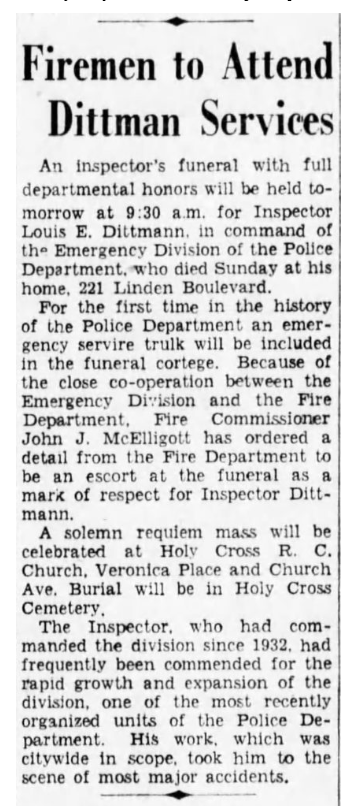
His funeral was on May 5th. This is the first funeral in which an Emergency Service truck participated. Note the participation of the FDNY as well.
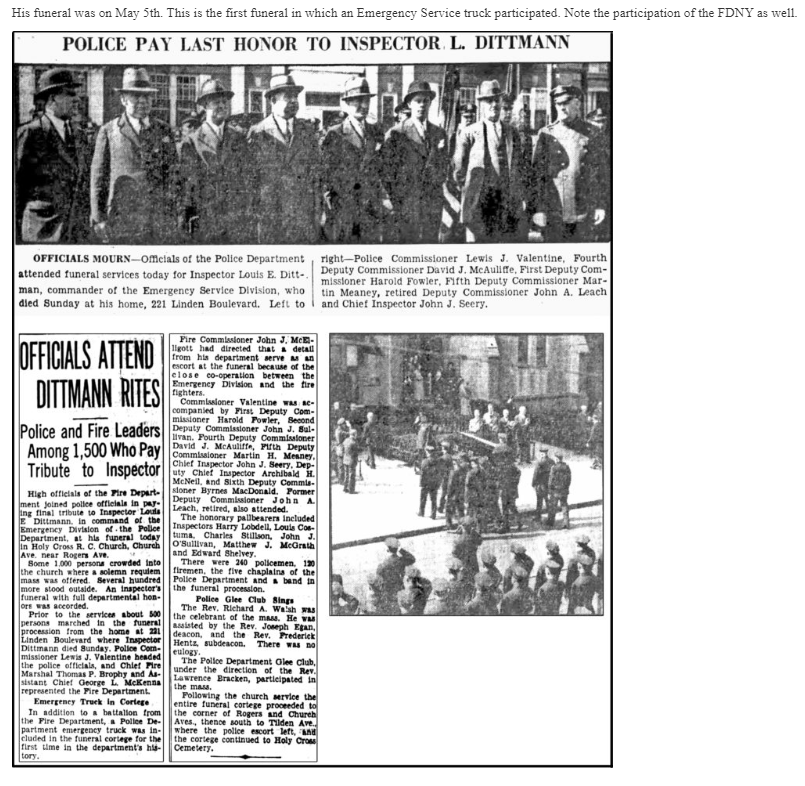
1939 – Emergency Service Division
400 Broome Street, Manhattan
C.O. Insp. Arthur W. Wallander
X.O. Deputy Insp. Henry Malley
Telephone # Canal 6-2000 Ext. 380 & 381
Squad Number Location
- 16 Ericsson Place, Manhattan
- 130 Sheriff Street, do
- 138 West 30th Street, do
- 217 East 21st Street do
- 1854 Amsterdam Ave.
- 209 East 122 Street do
- 1086 Simpson Street, Bronx
- 2120 Ryer Ave. do
- 3016 Webster Ave. do
- 78 Richmond Terrace, St. George Staten Island
- 1423 Avenue U Brooklyn
- 4203 Fourth Ave. do
- 44 Rapelyea Street do
- 484 Liberty Ave. do
- 653 Grand Ave. do
- 43 Herbert Street do
- 103-51 101 Street Queens
- 5-47 50th Avenue do
- 40-30 214 Place Bayside
- 92-94 Rockaway Boulevard, Belle Harbor
NOTE: The Harbor Precinct and the Aviation Bureau were under Emergency Service Division, creating the ‘Land, Sea and Air’ coverage of NYC. Harbor was located at Pier A North River and Aviation was located at Hangar # 4 Floyd Bennett Field, Brooklyn.
1948 Emergency Service Division
1948 Emergency Service Division – Created April 1, 1930. Included Harbor & Aviation Units.
(Main Office at 400 Broome St):
Manhattan:
-
4th Pct – 16 Ericson Pl.
- 13th Pct – 327 E 22 St.
- 18th Pct – 306 W 54 St
- 25th Pct – 148 E 126 St
- 30th Pct – 1854 Amsterdam Ave
Bronx:
-
42nd Pct – 160 St & Cypress Ave
- 46th Pct – 2120 Ryer Ave
-
52nd Pct – 3016 Webster Ave
Brooklyn:
-
61st Pct – 1423 Avenue U
- 68th Pct – 4302 4th Ave
- 75th Pct – 484 Liberty Ave
- 80th Pct – 653 Grand Ave
- 82nd Pct – 17 Butler St
-
87th Pct – 43 Herbert St
Queens:
- 100th Pct – 92-24 Rockaway Beach Blvd
- 106th Pct – 103-51 101 St
- 108th Pct – 5-47 50th Ave
- 111th Pct – 40-30 214 St
Staten Island:
-
120th Pct – 78 Richmond Ave
Harbor Precincts (Main Office at Pier A, North River) consisted of 12 launches:
- 2nd Pct – Pier A
- 23rd Pct – Wards Island
- 45th Pct – Throgs Neck
- 61 Pct – Sheepshead Bay (?)
- 68th Pct –
- 109th Pct – College Point
- 120th Pct – Ferry Terminal (?)

REMA NOTE: We are very grateful to Sergeant Mike Bosak for allowing us to use his “History of NYPD’s Emergency Service”. His tireless research is immeasurable.
In addition, Inspector Walter Klotzback, rose through the ranks of ESU from cop to Commanding Officer reflects on the first 25 years of ESD in a 1950 Daily News article found HERE.

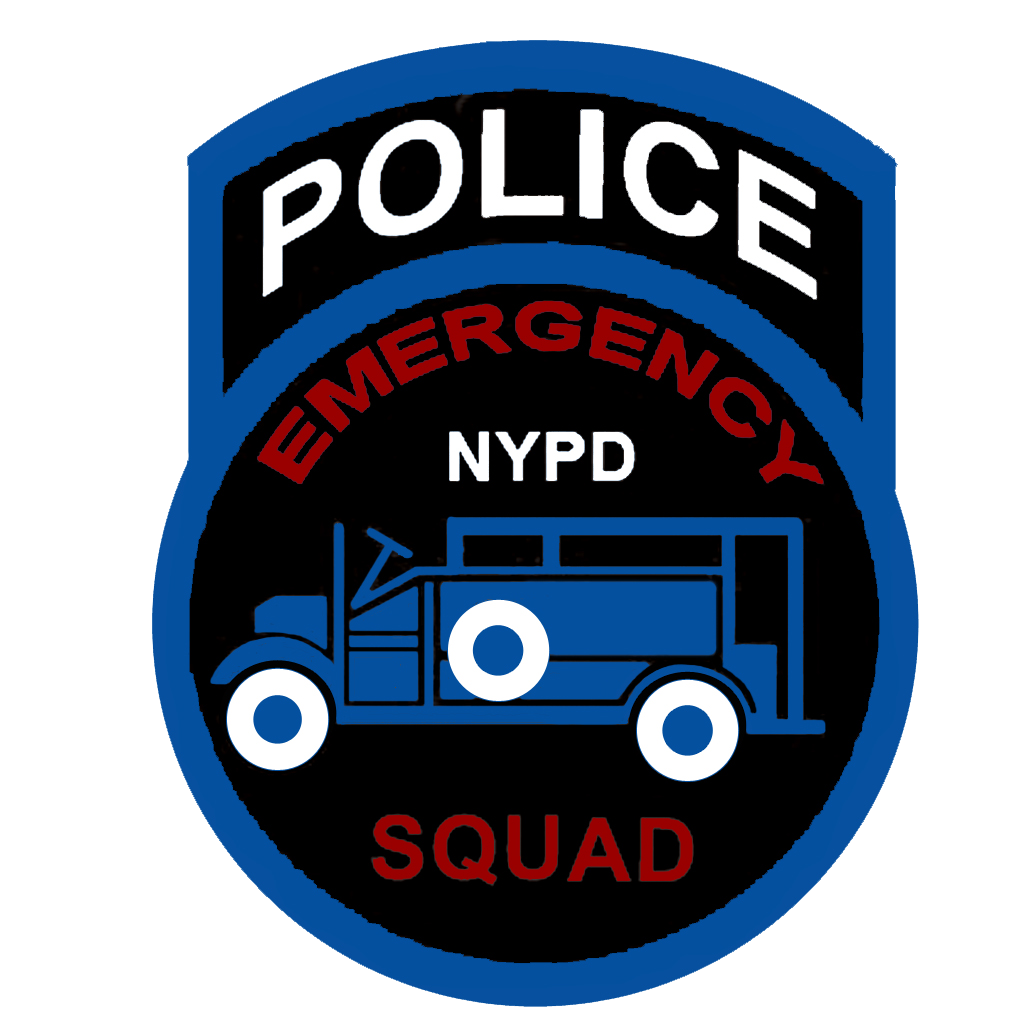

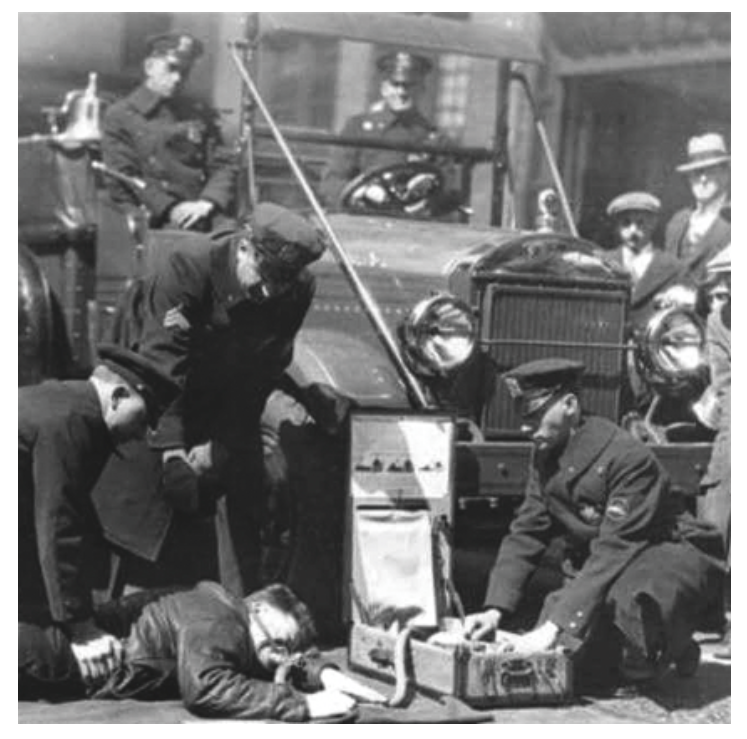
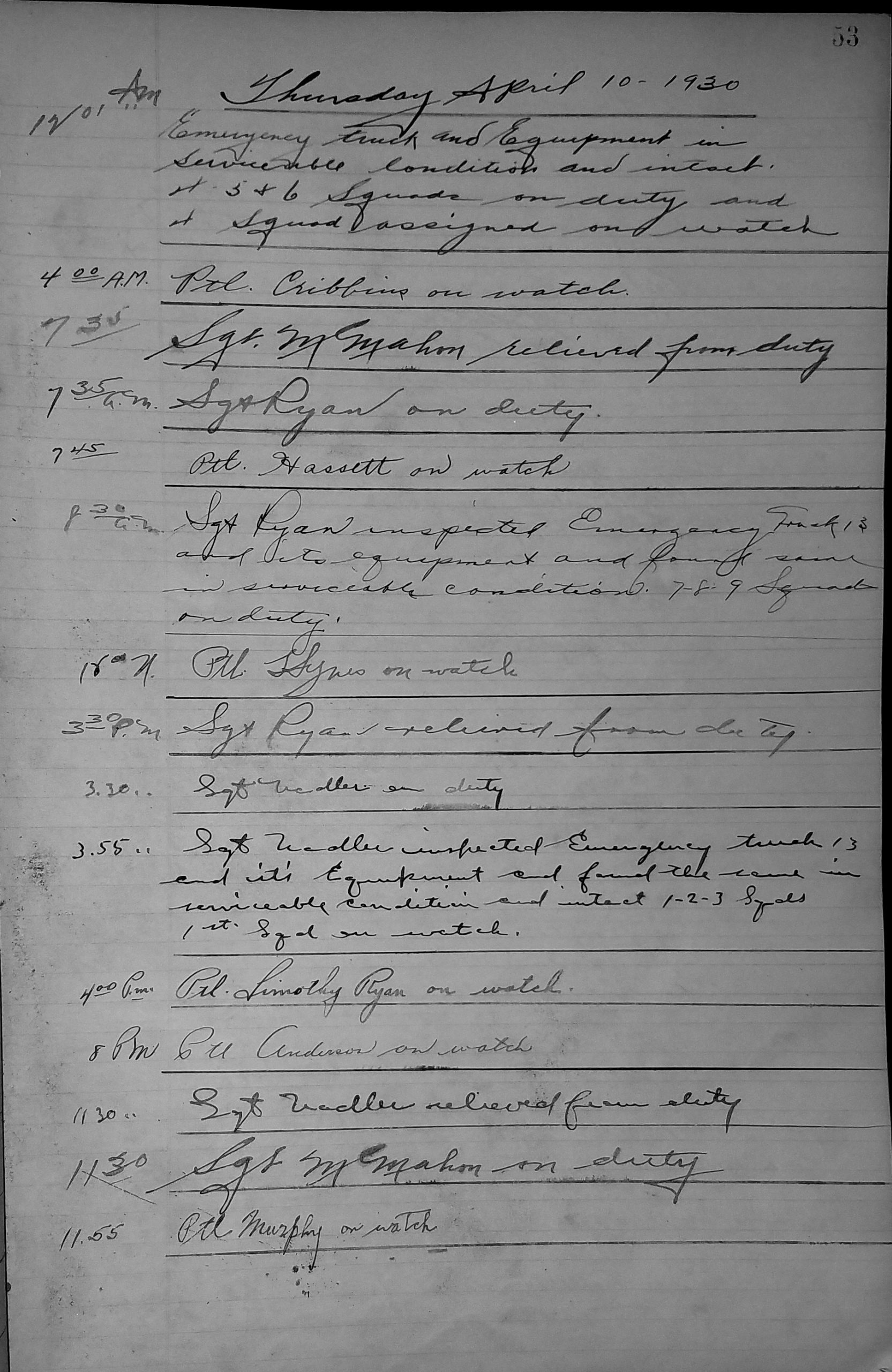
I have to say that it was a pleasure to serve in the Emergency Service Unit. The Men and Woman In the Unit were dedicated to and loyal. It certainly was my highlight and greatest experience .
Excellent work by those who did the research.
Thank you to everyone who went out of their way to research and compile all this outstanding history. This gives me an enormous amount of pride in being a small part of this amazing group of cops.
Twenty out of twenty-five years in ESU. The best years of my life.
Jose Otero ESS #3
was fortunate enough to learn and work with 2 outstanding senior E-MEN
Keith Broderick and Tony Johnson thank you for the well taught lessons i continue to pass on
.
So very interesting. Thanks for such a detailed article!
Makes you feel proud to have worked in ESU and have helped in so many situations threw out the city and many years God Bless everyone 🇺🇸 and for all the members we have lost 🙏
Outstanding, This will be required reading at the school . Very detailed and full of history.
Active ESS #3
In the 50’s and 60’s worked with former Open Truck E men, Charlie Pitney, Howie Langer, Paddy Walsh & Ed Zach, At ESD school. with Jeff Pfeiffer & Charlie Bondi.
In the 50’s and 60’s I worked with former Open Truck E men, Charlie Pitney, Howie Langer, Ed Zach, Paddy Walsh and at ESD training school Jeff Pfeiffer and Charley Bondi. Learned a lot from them.
Excellent History of the origin of ESD…the Finest of the Finest. Much thanks to the staff of REMA for this publication.
Great 😃
EXCELLENT article. Best, most detailed I’ve ever seen on the origins, early history of ESU..